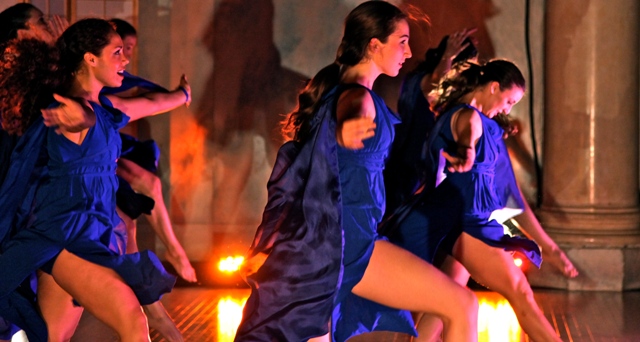
At the end of his excellent book Mastery (New York: Viking, 2012), after carefully composing the argument that genius is available to everyone and delineating the steps necessary to cultivate it, Robert Greene makes the following claim:
... The design of the human brain -- its inherent need to make connections and associations -- gives it a will of its own. ...The artificial barriers between the arts and sciences will melt away under the pressure to know and to express our common reality. Our ideas will become closer to nature, more alive and organic. In any way possible, you should strive to be a part of this universalizing process, extending your own knowledge to other branches, further and further out. The rich ideas that will come from such a quest will be their own reward.
This passage came back to me as I watched a dress rehearsal for THE MARCHES! 136th Birthday of Isadora Duncan, presented by Lori Belilove and the Isadora Duncan Dance Company. For one, Isadora Duncan herself was a master. She was a big, rich personality brimming with ideas -- she was a performer, a choreographer, a feminist, an educator, an author, and a philosopher. She was an iconoclast who defied the rigid dance conventions of the time. She invented an open-hearted, graceful form of dance. Her work was so beautiful that it radiated a shocking yet lyrical urgency -- and it forever opened the world to the possibilities of physical, musical expression by the human body.
Duncan was called the "Mother of Modern Dance" and her legacy continues with artistic director Lori Belilove's loving ongoing inquiry into Duncan's dance ideals: free-spiritedness married to beauty, philosophy, and humanity.
But it wasn't the historical weight of the dance pieces, nor was it the delicious sense of being in the presence of a master alive in her work, that evoked Mastery. Greene's passage resonated in me because of the organic interconnectedness, naturalness, and universality of Duncan's work.
Human beings are complex and multidimensional. Our feelings run the gamut from murderous rage and bleak despair to joy, sensual bliss, and unconditional, agape love. Our actions exhibit this huge spectrum. So do our interests. We operate on many levels at once, from the physical to the emotional to the psychological to the social to the political to the spiritual; we are comprised of many selves who can never be separated, and our multifaceted nature entwines us with others. The pieces in the The Marches! abound with this vast, alive sense of our shared humanity. And that's a precious antidote to the fragmentation, specialization, and virtualization of modern life.
There was the inherent visual pleasure of well-trained bodies moving through space: long columns of necks, lithe, rounded limbs, fluttering silk tunics. The music -- Berlioz, Schubert, and Tchaikovsky soared around and through the dancers.
Then there were the characteristic Duncan movements and gestures that expand upward and outward from the solar plexus and flow through the body as a whole: uplifted chests, poetically arced arms, impossibly fluid leg lifts and flying leaps.
Music and movement were completely integrated to produce a distilled essence of grace: sweetness with purity. It was thrilling to behold. This is great dance, and it is timeless, like any other great work of art, be it the Venus de Milo or Botticelli's Birth of Venus.
The Marches! offers poignant layers of meaning and cathartic experience. This collection showcases Slow March, Isadora's great work of despair and sorrow following the death of her two children in a car crash in Paris. Initially consumed with grief, Duncan summoned her genius to express wrenching loss, which unavoidably besets the human condition. This dance ends with hope and renewal, reminding us of our resilience and our love, which transcends death.
This dance feels particularly relevant to modern life, where death is denied, stigmatized, and hidden. In many places, it's illegal for anyone other than an undertaker to handle a dead body, which is whisked out of sight as quickly as possible, to preserve a deluded sensibility which insists on the callow eternal youth of a beer advertisement. We no longer understand grief.
Nothing reminds us of our shared humanity so fully as death, whether it be the deaths of innocents in an accident or at the hands of a gunman or terrorist, or the quiet close of a long life, in the company of family. We all experience the same ultimate fate. It's imperative that those who continue after us remember their strength, that they return to the joy and potential of the moment.
There is a blessing intrinsic to simply being alive and The Marches! embodies that blessing. As director and lead dancer Belilove says, "Duncan's work is about living life to the fullest. ... You must be present in the moment. You can't be walking down the street, wearing high heels and texting. You can't retreat, you can't be a wallflower. You have to live fully in the moment, doing your best."
Marche Heroique is Duncan's response to World War I, the devastating Great War that would, eventually, morph into World War II and catastrophically shape the 20th century. Duncan was a polymath, seeing the connections between art and civilization, and very much involved in politics. Her dance organically expresses the connection between the body politic and the body human. The dancers wear billowing red tunics that wreak passion onto the very air. They plant flags of humanity which represent a call to protect Europe. Rise to the challenge, this glorious dance proclaims, because the stakes are high.
In the end, The Marches! is a rich spectacle that throbs with life, with connections, with provocative commentary on our shared humanity. It illustrates Greene's principles of mastery, and leaves its audience elevated in the process.
Catch it at the Ailey Citigroup Theater on May 16, 17 and 18.

© Stephen de las Heras
